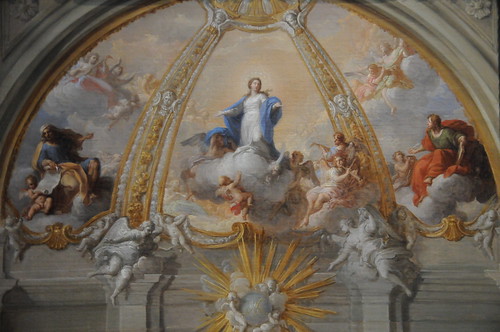Immaculate Conception
7:00 AM |
| Placido Costanzi, Immaculate Conception, circa 1730 |
Although Costanzi's Immaculate Conception now sits at The Getty, you can tell that it was once destined for - you guessed it - a church. Costanzi, an Italian rococo painter, painted the sloping boughs as a modello of what would actually be built (personally, I like it better that way). The painting, as titled, depicts the moment of Mary's miraculous pregnancy - only here in high Rococo style. As opposed to Fra Angelico's painting of Gabriel's announcement, Costanzi's Mary rises from the clouds, surrounded by angels and almost enough cherubs to be dubbed Fragonard-esque.
Two saints flank the emergin' virgin, and even more cherubs hanging off of them. Saint Luke, on the left, points towards Mary with one hand while holding a piece of paper that reads "Ecce Virgo" which translates to "Behold the Virgin." Saint Luke was the writer of Gospels and the Acts of the Apostles, and thus naturally holds a script in his hand. To the left of Mary, sits the Apostle St. John the Evangelist, dressed in his traditional red and green robes. He holds a pen and papers in his hand, documenting the miracle of Mary's pregnancy, like a really, really old fashioned pregnancy test of the Lord. Front and center Mary stands, with eyes turned upwards and arms open in acceptance. She wears blue, as always, and a halo of stars can faintly be seen encircling her head. Angels play music at her feet, while cherubs climb on her, around her, and even hide under her clothes, celebrating. Costanzi's career consisted of mainly religious paintings, but I think that his Immaculate Conception most accurately portrays the artistic influence that Rococo had on religious works
0 comments